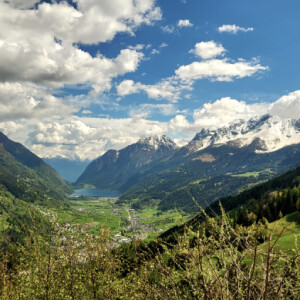Bernina Pass
My tedious long journey yesterday was an investment in today: to travel on the Bernina Express through the Swiss Engadin Alps.
I always aim to get to stations, especially those I don't know, with oodles of time to spare. Just in case... So I left the hostel this morning 50 minutes before my train was due to leave Milano Centrale, only 12 minutes walk away. Since my ticket ominously said there were no seat reservations, I checked for its platform when I arrived. Not announced. Good. Time for a quick coffee. One quickish coffee later, 25 minutes before the train was due to leave, I was surprised to see the platform announced and the train there. The back was already crowded but eight carriages further along the platform I spotted a forward-facing window seat and claimed it. By the time the train left there were far more people standing than seated, even in my carriage far from the ticket barrier. I wonder what it was like at the back. A good reminder to move sharply today, since window seats are the motivation for this contorted route homewards.
At Varenna Esino almost everyone got off - holidaying on Lake Como? Must try that sometime.
The Bernina Express leaves Tirano, 441m above sea level, almost 2km below its highest point, 2253m at the Bernina Pass. Soon after we left, I was on the lookout for the 116-year-old Brusio Spiral Viaduct. Although I was well aware of its tight steep curve, and could see the viaduct arches, pictures of it from outside the train are much better than any I managed.
I was glued to the windows for most of the spectacular four-hour journey but I was in the minority. There are plenty of walkers and cyclists, who've travelled this way before, and local people who pull down the blinds and read, do phone stuff, or doze.
In contrast, I was exhilarated to be on the highest railway track in Europe, the steepest in the world (70m climb per km at its steepest - the track is 122km long for about 87km as crow flies) and one of only four railway journeys in the world which is a UNESCO World Heritage Site (the others are all in India).
As we wound up and across deep valleys and gorges (there are 196 bridges, all built in the late 19th and early 20th centuries) and through 55 tunnels bored into mountain rock, I was getting excited at crags, trees, no trees, white torrents, tumbling rocky rivers the glassy green of glacier melt, and snow on the peaks.
At the Bernina Pass the snow was 500mm deep on either side of the track and we looked up the valley to a glacier. My first ever experience of a glacier was close to here, above Zermatt, as a hanger-on with a 1976 university geography field trip, and I can't help wondering how much of the glacier I slept next to has since become sea water.
Towards the end of the journey, we went over a narrow gorge on the 65m high curved Landwasser Viaduct that leads straight into a tunnel. I didn't know how high 65m is until I looked down at the valley. It's dizzyingly high from a train window - a fabulous bit of engineering.
As the mountains got (slightly) lower there were more settlements, and a surprising number of castles built on craggy outcrops.
I had no idea until I got to Chur, at the end of this line, that its other name is Davos. I did not seek out the great and the evil. Anyway, they weren't here - they come in the skiing season.
From Chur, I caught a train to Zurich for the night. Of course the geography is not as tidy as the railway lines and the fabulous scenery continued right down to the turquoise Walensee in the evening sun.
I was exhausted, despite having done much less walking than usual and once I'd dumped my bags, had just a short walk round evening Zurich.


Comments
Sign in or get an account to comment.


